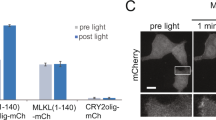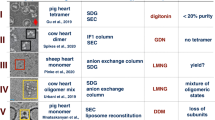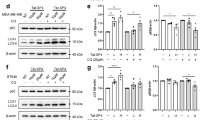Abstract
While necrotic cell death is attracting considerable interest, its molecular bases are still poorly understood. Investigations in simple biological models, taken for instance outside the animal kingdom, may benefit from less interference from other cell death mechanisms and from better experimental accessibility, while providing phylogenetic information. Can necrotic cell death occur outside the animal kingdom? In the protist Dictyostelium, developmental stimuli induced in an autophagy mutant a stereotyped sequence of events characteristic of necrotic cell death. This sequence included swift mitochondrial uncoupling with mitochondrial 2′,7′-dichlorofluorescein diacetate fluorescence, ATP depletion and increased oxygen consumption. This was followed by perinuclear clustering of dilated mitochondria. Rapid plasma membrane rupture then occurred, which was evidenced by time-lapse videos and quantified by FACS. Of additional interest, developmental stimuli and classical mitochondrial uncouplers triggered a similar sequence of events, and exogenous glucose delayed plasma membrane rupture in a nonglycolytic manner. The occurrence of necrotic cell death in the protist Dictyostelium (1) provides a very favorable model for further study of this type of cell death, and (2) strongly suggests that the mechanism underlying necrotic cell death was present in an ancestor common to the Amoebozoa protists and to animals and has been conserved in evolution.
Similar content being viewed by others
Log in or create a free account to read this content
Gain free access to this article, as well as selected content from this journal and more on nature.com
or
Abbreviations
- CCCP:
-
carbonyl cyanide 3-chlorophenylhydrazone
- DC-FDA:
-
2′,7′-dichlorofluorescein diacetate
- DIF:
-
differentiation-inducing factor
- DNP:
-
dinitrophenol
- 2-DOG:
-
2-deoxyglucose
- PI:
-
propidium iodide
- VDAC:
-
voltage-dependent anion channel
References
Kerr JFR, Wyllie AH, Currie AR . Apoptosis: a basic biological phenomenon with wide-ranging implications in tissue kinetics. Br J Cancer 1972; 26: 239–257.
Clarke PGH, Clarke S . Historic apoptosis. Nature 1995; 378: 230.
Golstein P, Aubry L, Levraud JP . Cell-death alternative model organisms: why and which? Nat Rev Mol Cell Biol 2003; 4: 798–807.
Lemasters JJ . Dying a thousand deaths: redundant pathways from different organelles to apoptosis and necrosis. Gastroenterology 2005; 129: 351–360.
Syntichaki P, Tavernarakis N . The biochemistry of neuronal necrosis: rogue biology? Nat Rev Neurosci 2003; 4: 672–684.
Leist M, Single B, Castoldi AF, Kuhnle S, Nicotera P . Intracellular adenosine triphosphate (ATP) concentration: a switch in the decision between apoptosis and necrosis. J Exp Med 1997; 185: 1481–1486.
Eguchi Y, Shimizu S, Tsujimoto Y . Intracellular ATP levels determine cell death fate by apoptosis or necrosis. Cancer Res 1997; 57: 1835–1840.
Baldauf SL, Roger AJ, Wenk-Siefert I, Doolittle WF . A kingdom-level phylogeny of eukaryotes based on combined protein data. Science 2000; 290: 972–977.
Whittingham WF, Raper KB . Non-viability of stalk cells in Dictyostelium. Proc Natl Acad Sci USA 1960; 46: 642–649.
Kay RR . Cell differentiation in monolayers and the investigation of slime mold morphogens. Methods Cell Biol 1987; 28: 433–448.
Cornillon S, Foa C, Davoust J, Buonavista N, Gross JD, Golstein P . Programmed cell death in Dictyostelium. J Cell Sci 1994; 107: 2691–2704.
Levraud JP, Adam M, Luciani MF, de Chastellier C, Blanton RL, Golstein P . Dictyostelium cell death: early emergence and demise of highly polarized paddle cells. J Cell Biol 2003; 160: 1105–1114.
Otto GP, Wu MY, Kazgan N, Anderson OR, Kessin RH . Macroautophagy is required for multicellular development of the social amoeba Dictyostelium discoideum. J Biol Chem 2003; 278: 17636–17645.
Kosta A, Roisin-Bouffay C, Luciani MF, Otto GP, Kessin RH, Golstein P . Autophagy gene disruption reveals a non-vacuolar cell death pathway in Dictyostelium. J Biol Chem 2004; 279: 48404–48409.
Halliwell B, Whiteman M . Measuring reactive species and oxidative damage in vivo and in cell culture: how should you do it and what do the results mean? Br J Pharmacol 2004; 142: 231–255.
Lieberthal W, Menza SA, Levine JS . Graded ATP depletion can cause necrosis or apoptosis of cultured mouse proximal tubular cells. Am J Physiol 1998; 274 (Part 2): F315–F327.
Leist M, Single B, Naumann H, Fava E, Simon B, Kuhnle S et al. Inhibition of mitochondrial ATP generation by nitric oxide switches apoptosis to necrosis. Exp Cell Res 1999; 249: 396–403.
Volbracht C, Leist M, Nicotera P . ATP controls neuronal apoptosis triggered by microtubule breakdown or potassium deprivation. Mol Med 1999; 5: 477–489.
Crowe JH, Crowe LM, Oliver AE, Tsvetkova N, Wolkers W, Tablin F . The trehalose myth revisited: introduction to a symposium on stabilization of cells in the dry state. Cryobiology 2001; 43: 89–105.
Shaulsky G, Loomis WF . Mitochondrial DNA replication but no nuclear DNA replication during development of Dictyostelium. Proc Natl Acad Sci USA 1995; 92: 5660–5663.
Fukuzawa M, Araki T, Adrian I, Williams JG . Tyrosine phosphorylation-independent nuclear translocation of a Dictyostelium STAT in response to DIF signaling. Mol Cell 2001; 7: 779–788.
Fukuzawa M, Abe T, Williams JG . The Dictyostelium prestalk cell inducer DIF regulates nuclear accumulation of a STAT protein by controlling its rate of export from the nucleus. Development 2003; 130: 797–804.
Zhukovskaya NV, Fukuzawa M, Yamada Y, Araki T, Williams JG . The Dictyostelium bZIP transcription factor DimB regulates prestalk-specific gene expression. Development 2006; 133: 439–448.
Huang E, Blagg SL, Keller T, Katoh M, Shaulsky G, Thompson CR . bZIP transcription factor interactions regulate DIF responses in Dictyostelium. Development 2006; 133: 449–458.
Eichinger L, Pachebat JA, Glockner G, Rajandream MA, Sucgang R, Berriman M et al. The genome of the social amoeba Dictyostelium discoideum. Nature 2005; 435: 43–57.
Killick KA, Wright BE . Multiple forms of glucokinase from Dictyostelium discoideum. J Bacteriol 1978; 133: 1039–1041.
Gottlob K, Majewski N, Kennedy S, Kandel E, Robey RB, Hay N . Inhibition of early apoptotic events by Akt/PKB is dependent on the first committed step of glycolysis and mitochondrial hexokinase. Genes Dev 2001; 15: 1406–1418.
Pastorino JG, Shulga N, Hoek JB . Mitochondrial binding of hexokinase II inhibits Bax-induced cytochrome c release and apoptosis. J Biol Chem 2002; 277: 7610–7618.
Danial NN, Gramm CF, Scorrano L, Zhang CY, Krauss S, Ranger AM et al. BAD and glucokinase reside in a mitochondrial complex that integrates glycolysis and apoptosis. Nature 2003; 424: 952–956.
Zaid H, Abu-Hamad S, Israelson A, Nathan I, Shoshan-Barmatz V . The voltage-dependent anion channel-1 modulates apoptotic cell death. Cell Death Differ 2005; 12: 751–760.
Nutt LK, Margolis SS, Jensen M, Herman CE, Dunphy WG, Rathmell JC et al. Metabolic regulation of oocyte cell death through the CaMKII-mediated phosphorylation of caspase-2. Cell 2005; 123: 89–103.
Le Goffe C, Vallette G, Charrier L, Candelon T, Bou-Hanna C, Bouhours JF et al. Metabolic control of resistance of human epithelial cells to H2O2 and NO stresses. Biochem J 2002; 364 (Part 2): 349–359.
Richards TA, Cavalier-Smith T . Myosin domain evolution and the primary divergence of eukaryotes. Nature 2005; 436: 1113–1118.
Golstein P, Kroemer G . Redundant cell death mechanisms as relics and backups. Cell Death Differ 2005; 12 (Suppl 2): 1490–1496.
Otto GP, Wu MY, Kazgan N, Anderson OR, Kessin RH . Dictyostelium macroautophagy mutants vary in the severity of their developmental defects. J Biol Chem 2004; 279: 15621–15629.
Chautan C, Chazal G, Cecconi F, Gruss P, Golstein P . Interdigital cell death can occur through a necrotic and caspase-independent pathway. Curr Biol 1999; 9: 967–970.
Roisin-Bouffay C, Luciani MF, Klein G, Levraud JP, Adam M, Golstein P . Developmental cell death in Dictyostelium does not require paracaspase. J Biol Chem 2004; 279: 11489–11494.
Leist M, Jaattela M . Four deaths and a funeral: from caspases to alternative mechanisms. Nat Rev Mol Cell Biol 2001; 2: 589–598.
Sussman M . Cultivation and synchronous morphogenesis of Dictyostelium under controlled experimental conditions. In: Spudich JA (ed). Methods in Cell Biology. Harcourt Brace Jovanovich: New York, 1987, pp. 9–29.
Kay RR . Cell differentiation in monolayers and the investigation of slime mold morphogens. In: Spudich JA (ed). Methods in Cell Biology. Ac. Press: Orlando, FL, 1987, pp. 433–448.
Acknowledgements
We thank INSERM and CNRS for institutional support, and for specific grants Agence Nationale pour la Recherche (DictyDeath ANR-05-BLAN-0333-01), the European Community (FP6 STREP TransDeath LSHG-CT-2004-511983), the Ministère pour la Recherche (ACI BCMS174), Cancéropôle PACA and Association pour la Recherche contre le Cancer. We thank Jonathan Ewbank, Didier Marguet, Pierre-Henri Puech and Gérard Brandolin for helpful discussions and reading the manuscript.
Author information
Authors and Affiliations
Corresponding author
Additional information
Edited by JA Cidlowski
Supplementary Information accompanies the paper on Cell Death and Differentiation website (http://www.nature.com/cdd)
Rights and permissions
About this article
Cite this article
Laporte, C., Kosta, A., Klein, G. et al. A necrotic cell death model in a protist. Cell Death Differ 14, 266–274 (2007). https://doi.org/10.1038/sj.cdd.4401994
Received:
Revised:
Accepted:
Published:
Issue date:
DOI: https://doi.org/10.1038/sj.cdd.4401994
Keywords
This article is cited by
-
Computational classification of mitochondrial shapes reflects stress and redox state
Cell Death & Disease (2013)
-
Necroptosis: Biochemical, Physiological and Pathological Aspects
Pathology & Oncology Research (2011)
-
Fractal avalanche ruptures in biological membranes
Nature Materials (2010)
-
Autophagy and cell death in model organisms
Cell Death & Differentiation (2009)
-
Autophagic or necrotic cell death triggered by distinct motifs of the differentiation factor DIF-1
Cell Death & Differentiation (2009)



